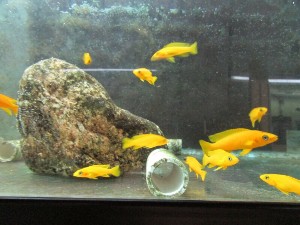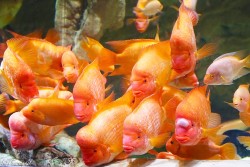Lemon Cichlid (Neolamprologus leleupi) CareSheet

The Lemon Cichlid (Neolamprologus leleupi), commonly known as the Orange Cichlid, is a tiny and energetic rock-dwelling cichlid endemic to Africa's Lake Tanganyika's southern coastline sections. In the aquarium hobby, it is quite popular. It spawns on rocks in the wild. Males are bigger than females, and the whole body is golden to orange in color.
In an aquarium with caverns formed by heaps of rocks, the Lemon Cichlid will flourish. The optimum substrate for this species is sand. Mature fish will often claim and defend a small area in the vicinity of their rock piles and caves. Because this cichlid prefers the middle and higher levels of the water column, it may frequently be housed (in a large tank) alongside Tanganyikan shell-eating species that prefer the lower levels. This species is modest in size, yet it is very territorial when it comes to its own kind and related fish. During spawning, territoriality is usually at its height. Lemon Cichlids should not be housed alongside dwarf shrimp or other tiny, sensitive invertebrates. If spawning is desired, other species should be kept to a minimum or avoided entirely unless the aquarium is large enough with enough of cover and aquascaping.
For the uncomplicated Lemon Cichlid, feeding is a breeze. Dry, frozen,
freeze dried plankton, and live meaty items of high quality will all be welcomed. This species should not be fed dry items entirely since quality and diversity are the keys to a diet that will guarantee that it maintains maximum health and colour. It is largely a carnivore, although it needs some vegetable materials like
vegi flake food in its diet as well.
Requirements for keeping Neolamprologus leleupi
Temperature: 73.4° - 81° F
pH: 7.5 - 9.0
KH: 9 - 25 dKH
Minimum tank size: 20 gallons for an adult pair, 55+ gallons for a group
Origin: Indigenous to Lake Tanganyika, Africa
Average adult size: 4 inches

Neolamprologus leleupi - stages of reproduction
FAQ's
What is the natural habitat of Neolamprologus leleupi?
Neolamprologus leleupi is native to Lake Tanganyika in East Africa. They are typically found in rocky habitats, particularly among crevices and caves, where they seek shelter.
How large do Neolamprologus leleupi typically grow?
Neolamprologus leleupi is a small to medium-sized cichlid species, with adults reaching an average size of about 4 to 5 inches (10-12.5 cm) in length.
Can I keep Neolamprologus leleupi in a community aquarium?
Neolamprologus leleupi is known for its territorial and sometimes aggressive behavior, especially during breeding. It's best to keep them in a species-specific tank or with other Tanganyikan cichlid species that share similar water requirements and temperaments.
What are the ideal water parameters for Neolamprologus leleupi?
To ensure the well-being of Neolamprologus leleupi, maintain water conditions that resemble their natural habitat. Aim for a pH level between 7.8 and 9.0, a water temperature of 75-82°F (24-28°C), and moderate to high water hardness (10-20 dGH).
What should I feed Neolamprologus leleupi?
Neolamprologus leleupi are omnivorous and can be fed a diet that includes high-quality cichlid pellets or flakes, live or frozen foods like brine shrimp, bloodworms, and small crustaceans. Offering a diverse diet is essential to meet their nutritional needs.
How should I set up the perfect aquarium for Neolamprologus leleupi?
Creating an ideal habitat for Neolamprologus leleupi involves using a sandy substrate, numerous rocky hiding places, and caves for shelter. Adequate filtration and regular water changes are essential to maintain water quality.
Can Neolamprologus leleupi be kept in pairs or groups?
Neolamprologus leleupi can be kept in pairs or small groups, but they can be territorial, especially when breeding. Providing ample hiding spots and territory can help reduce aggression in a group setup.
How can I differentiate between male and female Neolamprologus leleupi?
In Neolamprologus leleupi, males are typically larger and may exhibit brighter colors, especially during breeding. Females are generally smaller and may have less intense coloration.
What is the breeding behavior of Neolamprologus leleupi?
Neolamprologus leleupi is a substrate-spawning cichlid. The female lays her eggs in a carefully prepared cavity or crevice, and the male guards and protects the eggs until they hatch. The fry are guarded by both parents and can be initially fed on newly hatched brine shrimp or crushed flakes.
Are there any common health issues that Neolamprologus leleupi are prone to?
Like all aquarium fish, Neolamprologus leleupi can be susceptible to common diseases such as ich (white spot disease) and bacterial infections. Maintaining optimal water quality, providing a balanced diet, and quarantining new fish before introducing them to an established tank can help prevent health issues.
 The Lemon Cichlid (Neolamprologus leleupi), commonly known as the Orange Cichlid, is a tiny and energetic rock-dwelling cichlid endemic to Africa's Lake Tanganyika's southern coastline sections. In the aquarium hobby, it is quite popular. It spawns on rocks in the wild. Males are bigger than females, and the whole body is golden to orange in color.
The Lemon Cichlid (Neolamprologus leleupi), commonly known as the Orange Cichlid, is a tiny and energetic rock-dwelling cichlid endemic to Africa's Lake Tanganyika's southern coastline sections. In the aquarium hobby, it is quite popular. It spawns on rocks in the wild. Males are bigger than females, and the whole body is golden to orange in color.



